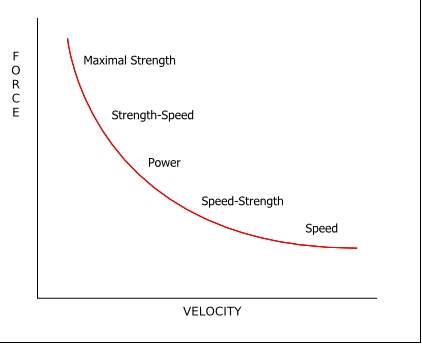More About Programming
by Erik Castiglione
Earlier this week I received a question from one of our newer members about why we rotate lifts, and why the percentages vary between light/medium/heavy. I broke out the HOW of our programming structure in a previous blog post, but now we can delve into the WHY.
The short and not very informative answer is that we follow what’s called a concurrent training approach. What does that mean? It means that we train several different things simultaneously. Generally speaking, training is either accomplished in a linear fashion (aka the “block” approach), or in a concurrent manner.
The linear training method is very common, especially for athletes. It makes a lot of sense when you have a competitive season, and an off-season. A true linear approach looks like this:
It’s a long, drawn out approach. And, since it’s so time consuming, it’s not practical in most instances – the off-season simply isn’t long enough. So, coaches began combining a couple training elements and training them simultaneously, creating training “blocks.” These blocks progress linearly with time leading into the competitive season. The approach looks like this:
In sport, the goal is to stay in peak condition through the season. Games take a toll on the body, and athletes need to recover. Adding in additional strength or fitness training makes athletes less able to recover. That’s why off-season training is a thing, and in season practices tend to focus on gameplay and preparation for opponents.
For people who do not have competitive seasons, the problem with the linear/block approach is that when you train attributes in a single block, you neglect all the others. Beginners can make progress with this method up to a point, but eventually, you stop making progress in the areas that you don’t train. For example, if you’re not strength training, you won’t get stronger. In fact, too much time spent training other attributes in place of strength can actually cause your strength to decline.
At Viking Athletics, we don’t have competitive seasons, so we want to avoid the pitfalls associated with linear and block training. Enter: concurrent training. Using this method, we train MULTIPLE quantities at the same time, rather than one or two. We outlined WHAT we train in a 3-part series (skill, conditioning, strength), but when it comes to strength specifically, we train absolute strength, strength-speed, power, and speed-strength. Each is best targeted using specific weight percentages. The fluctuation from week to week allows us to train without overloading ourselves. Skill development is also important, and that comes from PRACTICING each lift. By using 3 upper body and 3 lower body lifts each cycle (in addition clean and snatch variations), we ensure that you’re exposed to each movement frequently enough to improve your motor patterns.
To train both aerobic and anaerobic fitness, we vary our metcon intensity and duration, and couple it appropriately with our strength work. Depending on which benchmark we plan on testing, we may favor aerobic over anaerobic work, or vice versa. BUT, you will always train both. This approach allows us to make progress in the multiple areas on which we’re focusing, while still maintaining capacity in the less focused on area.
CrossFit in general is a concurrent training method. With so many different combinations of so many different movements, you’re going to end up training many things simultaneously. The KEY is to structure and organize training so that we can drive progress and allow for recovery. This is done by creating a PROGRAM, rather than just a collection of workouts. A program progresses over time, and provides metrics to measure success. A collection of workouts is just random movements that cause people to sweat, creating the illusion of effective exercise. And, it is not a recipe for long-term success. Programs are VASTLY superior, and we take great pride in ours here at Viking Athletics.



